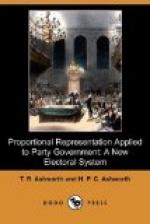+Election by Each Party of its Most Popular Candidates.+—Still keeping in mind the six-seat electorate for the Federal Senate, we may note that there are two rival systems in the field—the scrutin de liste or Block Vote, in which each elector votes for any six of the candidates, and the Hare system, which allows each elector an effective vote for one candidate only. The adoption of either of these systems would be unfortunate. To force each elector to vote for six candidates is probably to require him to vote for more than he is inclined to support, and certainly for more than his party is entitled to return; and, also, to put it in the power of the majority to return all six senators. To allow him to vote for one candidate only, on the other hand, is to break up both parties into factions by allowing the favourites of sections within the parties to be elected, instead of those most in general favour with all sections composing each party. An intermediate position is therefore best. No elector should be required to vote for more than three candidates, and no elector should be allowed to vote for less. Because in the first place it is evident that each party will, on the average, return three senators, and, secondly, it may be taken for granted that even the minority will nominate at least three candidates. Two alternative proposals may be submitted as fulfilling these conditions:—
1. Each elector should vote for any three candidates, or
2. Each elector should
have six votes, and have the option of giving
two votes to individual candidates._
The first plan is the simpler, but the second is probably the better, as it allows more discrimination without sacrificing any of the advantages. Either proposal is practically equivalent to applying the Block Vote to each party separately; and whatever may be the objections to applying the Block Vote to two or more parties it is the simplest and best system to elect the candidates most in general favour when one party only is concerned. It is true that the majority will return rather more than one-half of the representatives and the minority rather less than one-half, so that the minority will have more votes in proportion to its strength. But with two parties of fairly equal but fluctuating strength the fairest way is to require each elector to vote for at least one-half of the number of representatives. Besides, apart from the fact that it is not known before the election how many seats each party will obtain, it is absolutely necessary that each elector shall have the same number of votes in order that each party be allotted its just share of representation. Moreover it is not proposed to limit the elector’s freedom of choice in the slightest by confining him to the candidates of one party. The great majority of electors will vote on party lines, because every vote given to a candidate of the opposing party tells against the




